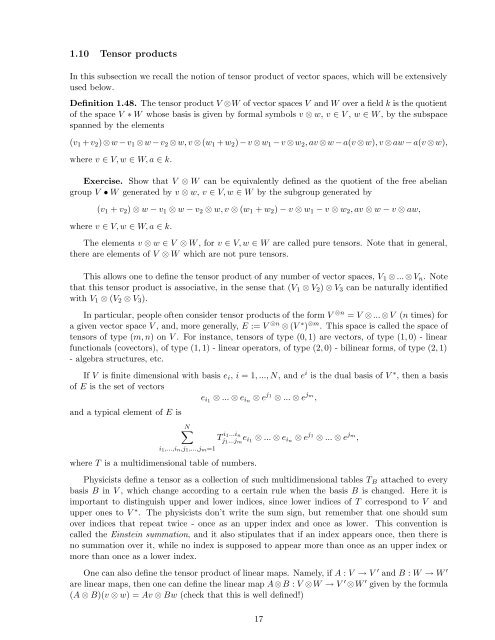Lecture notes for Introduction to Representation Theory
Lecture notes for Introduction to Representation Theory
Lecture notes for Introduction to Representation Theory
Create successful ePaper yourself
Turn your PDF publications into a flip-book with our unique Google optimized e-Paper software.
1.10 Tensor products<br />
In this subsection we recall the notion of tensor product of vec<strong>to</strong>r spaces, which will be extensively<br />
used below.<br />
Definition 1.48. The tensor product V W of vec<strong>to</strong>r spaces V and W over a field k is the quotient<br />
of the space V ∼ W whose basis is given by <strong>for</strong>mal symbols v w, v V , w W , by the subspace<br />
spanned by the elements<br />
(v 1 + v 2 ) w − v 1 w − v 2 w, v (w 1 + w 2 ) − v w 1 − v w 2 , av w − a(v w), v aw − a(v w),<br />
where v V, w W, a k.<br />
Exercise. Show that V W can be equivalently defined as the quotient of the free abelian<br />
group V • W generated by v w, v V, w W by the subgroup generated by<br />
(v 1 + v 2 ) w − v 1 w − v 2 w, v (w 1 + w 2 ) − v w 1 − v w 2 , av w − v aw,<br />
where v V, w W, a k.<br />
The elements v w V W , <strong>for</strong> v V, w W are called pure tensors. Note that in general,<br />
there are elements of V W which are not pure tensors.<br />
This allows one <strong>to</strong> define the tensor product of any number of vec<strong>to</strong>r spaces, V 1 ... V n . Note<br />
that this tensor product is associative, in the sense that (V 1 V 2 ) V 3 can be naturally identified<br />
with V 1 (V 2 V 3 ).<br />
In particular, people often consider tensor products of the <strong>for</strong>m V n = V ... V (n times) <strong>for</strong><br />
a given vec<strong>to</strong>r space V , and, more generally, E := V n (V ⊕ ) m . This space is called the space of<br />
tensors of type (m, n) on V . For instance, tensors of type (0, 1) are vec<strong>to</strong>rs, of type (1, 0) - linear<br />
functionals (covec<strong>to</strong>rs), of type (1, 1) - linear opera<strong>to</strong>rs, of type (2, 0) - bilinear <strong>for</strong>ms, of type (2, 1)<br />
- algebra structures, etc.<br />
If V is finite dimensional with basis e i , i = 1, ..., N, and e i is the dual basis of V ⊕ , then a basis<br />
of E is the set of vec<strong>to</strong>rs<br />
e i1 ... e in e j 1<br />
... e jm ,<br />
and a typical element of E is<br />
N<br />
T i 1...i n ... <br />
j 1<br />
j ein ... e jm 1 ...j m<br />
e i1 e<br />
,<br />
i 1 ,...,i n,j 1 ,...,j m=1<br />
where T is a multidimensional table of numbers.<br />
Physicists define a tensor as a collection of such multidimensional tables T B attached <strong>to</strong> every<br />
basis B in V , which change according <strong>to</strong> a certain rule when the basis B is changed. Here it is<br />
important <strong>to</strong> distinguish upper and lower indices, since lower indices of T correspond <strong>to</strong> V and<br />
upper ones <strong>to</strong> V ⊕ . The physicists don’t write the sum sign, but remember that one should sum<br />
over indices that repeat twice - once as an upper index and once as lower. This convention is<br />
called the Einstein summation, and it also stipulates that if an index appears once, then there is<br />
no summation over it, while no index is supposed <strong>to</strong> appear more than once as an upper index or<br />
more than once as a lower index.<br />
One can also define the tensor product of linear maps. Namely, if A : V ⊃ V and B : W ⊃ W <br />
are linear maps, then one can define the linear map A B : V W ⊃ V W given by the <strong>for</strong>mula<br />
(A B)(v w) = Av Bw (check that this is well defined!)<br />
17

















